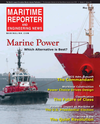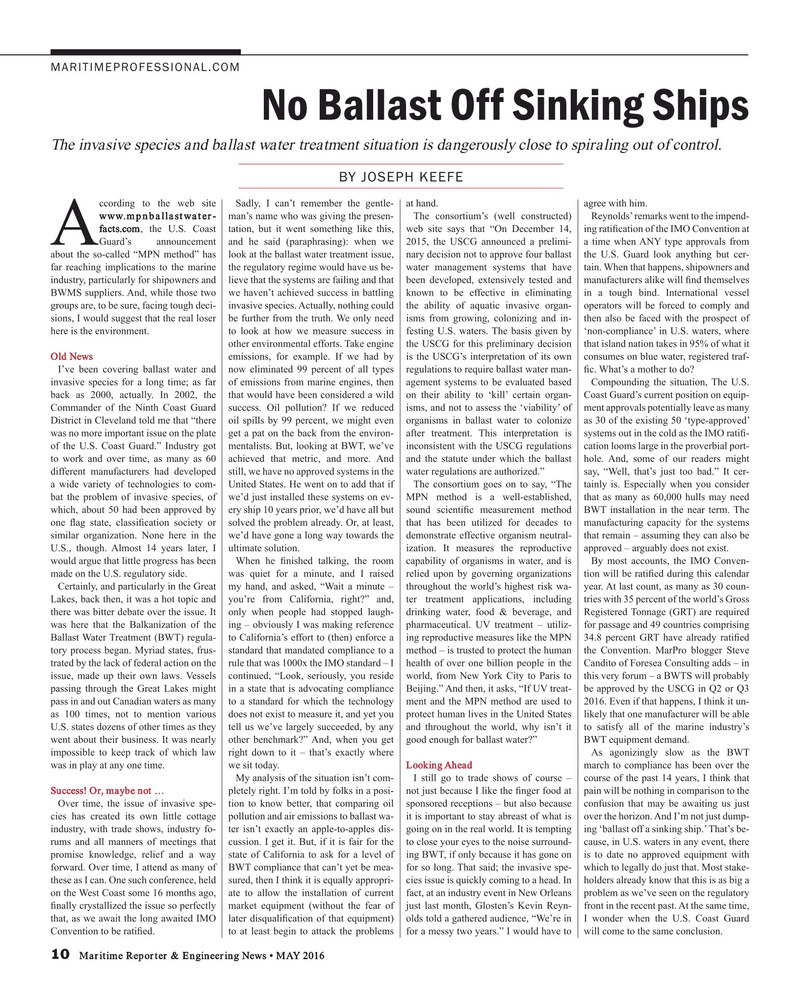
Page 10: of Maritime Reporter Magazine (May 2016)
The Marine Propulsion Edition
Read this page in Pdf, Flash or Html5 edition of May 2016 Maritime Reporter Magazine
MARITIMEPROFESSIONAL.COM
No Ballast Off Sinking Ships
The invasive species and ballast water treatment situation is dangerously close to spiraling out of control.
BY JOSEPH KEEFE ccording to the web site Sadly, I can’t remember the gentle- at hand. agree with him.
www.mpnballastwater- man’s name who was giving the presen- The consortium’s (well constructed) Reynolds’ remarks went to the impend- facts.com, the U.S. Coast tation, but it went something like this, web site says that “On December 14, ing rati? cation of the IMO Convention at
AGuard’s announcement and he said (paraphrasing): when we 2015, the USCG announced a prelimi- a time when ANY type approvals from about the so-called “MPN method” has look at the ballast water treatment issue, nary decision not to approve four ballast the U.S. Guard look anything but cer- far reaching implications to the marine the regulatory regime would have us be- water management systems that have tain. When that happens, shipowners and industry, particularly for shipowners and lieve that the systems are failing and that been developed, extensively tested and manufacturers alike will ? nd themselves
BWMS suppliers. And, while those two we haven’t achieved success in battling known to be effective in eliminating in a tough bind. International vessel groups are, to be sure, facing tough deci- invasive species. Actually, nothing could the ability of aquatic invasive organ- operators will be forced to comply and sions, I would suggest that the real loser be further from the truth. We only need isms from growing, colonizing and in- then also be faced with the prospect of here is the environment. to look at how we measure success in festing U.S. waters. The basis given by ‘non-compliance’ in U.S. waters, where other environmental efforts. Take engine the USCG for this preliminary decision that island nation takes in 95% of what it
Old News emissions, for example. If we had by is the USCG’s interpretation of its own consumes on blue water, registered traf-
I’ve been covering ballast water and now eliminated 99 percent of all types regulations to require ballast water man- ? c. What’s a mother to do?
invasive species for a long time; as far of emissions from marine engines, then agement systems to be evaluated based Compounding the situation, The U.S. back as 2000, actually. In 2002, the that would have been considered a wild on their ability to ‘kill’ certain organ- Coast Guard’s current position on equip-
Commander of the Ninth Coast Guard success. Oil pollution? If we reduced isms, and not to assess the ‘viability’ of ment approvals potentially leave as many
District in Cleveland told me that “there oil spills by 99 percent, we might even organisms in ballast water to colonize as 30 of the existing 50 ‘type-approved’ was no more important issue on the plate get a pat on the back from the environ- after treatment. This interpretation is systems out in the cold as the IMO rati? - of the U.S. Coast Guard.” Industry got mentalists. But, looking at BWT, we’ve inconsistent with the USCG regulations cation looms large in the proverbial port- to work and over time, as many as 60 achieved that metric, and more. And and the statute under which the ballast hole. And, some of our readers might different manufacturers had developed still, we have no approved systems in the water regulations are authorized.” say, “Well, that’s just too bad.” It cer- a wide variety of technologies to com- United States. He went on to add that if The consortium goes on to say, “The tainly is. Especially when you consider bat the problem of invasive species, of we’d just installed these systems on ev- MPN method is a well-established, that as many as 60,000 hulls may need which, about 50 had been approved by ery ship 10 years prior, we’d have all but sound scienti? c measurement method BWT installation in the near term. The one ? ag state, classi? cation society or solved the problem already. Or, at least, that has been utilized for decades to manufacturing capacity for the systems similar organization. None here in the we’d have gone a long way towards the demonstrate effective organism neutral- that remain – assuming they can also be
U.S., though. Almost 14 years later, I ultimate solution. ization. It measures the reproductive approved – arguably does not exist. would argue that little progress has been When he ? nished talking, the room capability of organisms in water, and is By most accounts, the IMO Conven- made on the U.S. regulatory side. was quiet for a minute, and I raised relied upon by governing organizations tion will be rati? ed during this calendar
Certainly, and particularly in the Great my hand, and asked, “Wait a minute – throughout the world’s highest risk wa- year. At last count, as many as 30 coun-
Lakes, back then, it was a hot topic and you’re from California, right?” and, ter treatment applications, including tries with 35 percent of the world’s Gross there was bitter debate over the issue. It only when people had stopped laugh- drinking water, food & beverage, and Registered Tonnage (GRT) are required was here that the Balkanization of the ing – obviously I was making reference pharmaceutical. UV treatment – utiliz- for passage and 49 countries comprising
Ballast Water Treatment (BWT) regula- to California’s effort to (then) enforce a ing reproductive measures like the MPN 34.8 percent GRT have already rati? ed tory process began. Myriad states, frus- standard that mandated compliance to a method – is trusted to protect the human the Convention. MarPro blogger Steve trated by the lack of federal action on the rule that was 1000x the IMO standard – I health of over one billion people in the Candito of Foresea Consulting adds – in issue, made up their own laws. Vessels continued, “Look, seriously, you reside world, from New York City to Paris to this very forum – a BWTS will probably passing through the Great Lakes might in a state that is advocating compliance Beijing.” And then, it asks, “If UV treat- be approved by the USCG in Q2 or Q3 pass in and out Canadian waters as many to a standard for which the technology ment and the MPN method are used to 2016. Even if that happens, I think it un- as 100 times, not to mention various does not exist to measure it, and yet you protect human lives in the United States likely that one manufacturer will be able
U.S. states dozens of other times as they tell us we’ve largely succeeded, by any and throughout the world, why isn’t it to satisfy all of the marine industry’s went about their business. It was nearly other benchmark?” And, when you get good enough for ballast water?” BWT equipment demand.
impossible to keep track of which law right down to it – that’s exactly where As agonizingly slow as the BWT was in play at any one time. we sit today. Looking Ahead march to compliance has been over the
My analysis of the situation isn’t com- I still go to trade shows of course – course of the past 14 years, I think that
Success! Or, maybe not … pletely right. I’m told by folks in a posi- not just because I like the ? nger food at pain will be nothing in comparison to the
Over time, the issue of invasive spe- tion to know better, that comparing oil sponsored receptions – but also because confusion that may be awaiting us just cies has created its own little cottage pollution and air emissions to ballast wa- it is important to stay abreast of what is over the horizon. And I’m not just dump- industry, with trade shows, industry fo- ter isn’t exactly an apple-to-apples dis- going on in the real world. It is tempting ing ‘ballast off a sinking ship.’ That’s be- rums and all manners of meetings that cussion. I get it. But, if it is fair for the to close your eyes to the noise surround- cause, in U.S. waters in any event, there promise knowledge, relief and a way state of California to ask for a level of ing BWT, if only because it has gone on is to date no approved equipment with forward. Over time, I attend as many of BWT compliance that can’t yet be mea- for so long. That said; the invasive spe- which to legally do just that. Most stake- these as I can. One such conference, held sured, then I think it is equally appropri- cies issue is quickly coming to a head. In holders already know that this is as big a on the West Coast some 16 months ago, ate to allow the installation of current fact, at an industry event in New Orleans problem as we’ve seen on the regulatory ? nally crystallized the issue so perfectly market equipment (without the fear of just last month, Glosten’s Kevin Reyn- front in the recent past. At the same time, that, as we await the long awaited IMO later disquali? cation of that equipment) olds told a gathered audience, “We’re in I wonder when the U.S. Coast Guard
Convention to be rati? ed. to at least begin to attack the problems for a messy two years.” I would have to will come to the same conclusion. 10 Maritime Reporter & Engineering News • MAY 2016
MR #5 (10-17).indd 10 MR #5 (10-17).indd 10 4/29/2016 3:31:01 PM4/29/2016 3:31:01 PM

 9
9

 11
11
